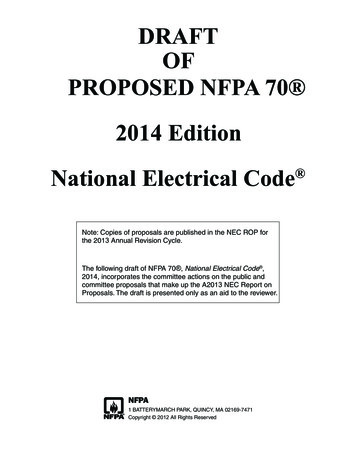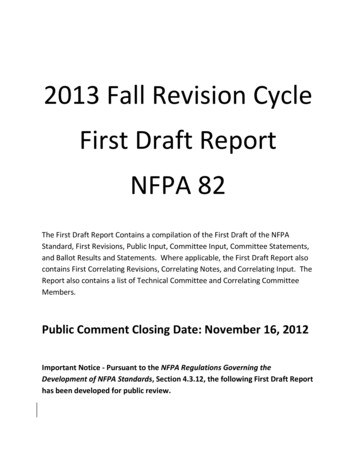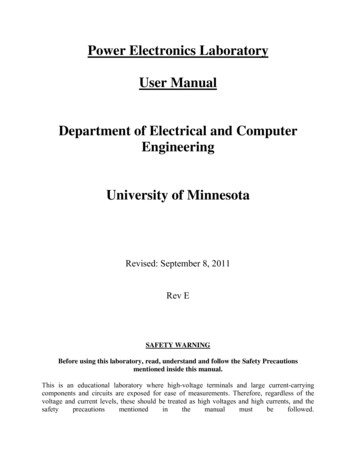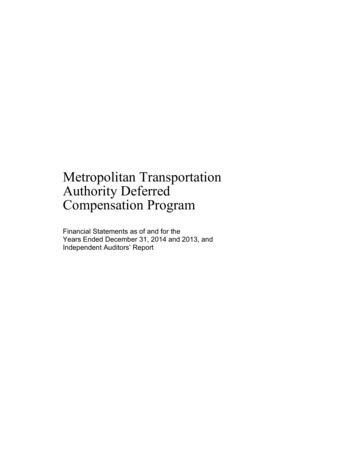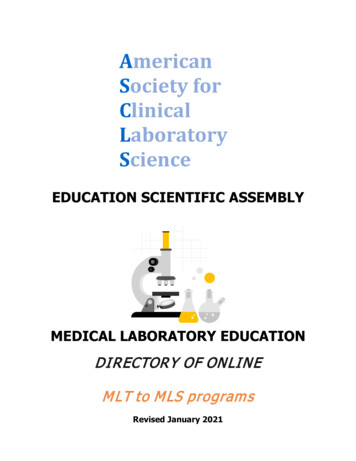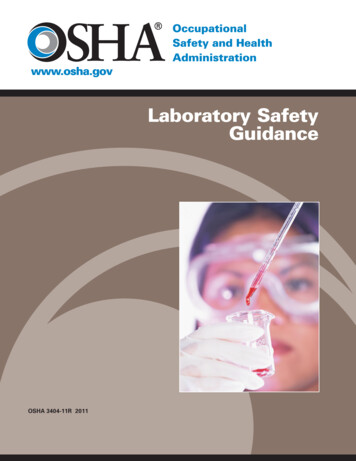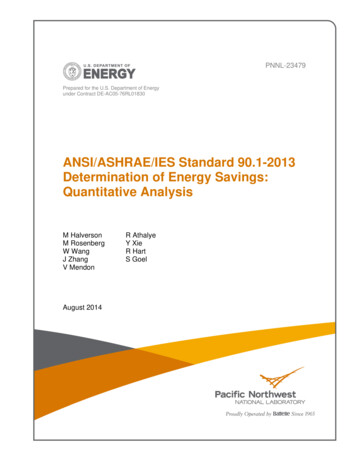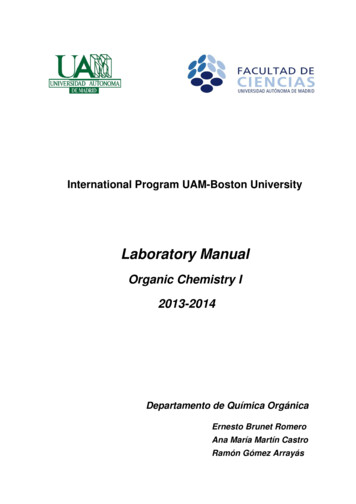
Transcription
International Program UAM-Boston UniversityLaboratory ManualOrganic Chemistry I2013-2014Departamento de Química OrgánicaErnesto Brunet RomeroAna María Martín CastroRamón Gómez Arrayás
Laboratory ManualTable of Contents.1Introduction.2Prelab preparation.2Notebook.3.3Laboratory Practices and Safety Rules .4Accidents and injuries.5Fires.5Chemical Wastes.6Cleaning Responsibilities.6Lab cleanliness.6Laboratory Equipment.7Proper use of glassware.8SafetySome techniques in lab experimentsHeating, cooling and stirring .9Measurements.10Extraction.10TLC chromatography.13Recrystallization.18.23Common organic solventsExperiment 1: Using Extraction and NMR to isolate and identify the analgesic activeprinciples of a sample.24Experiment 2: Preparation of an azoic dye: Para-red .35Annex to Experiment 2: Acetanilide nitration: a 1H-NMR exercise .Experiment 3: Synthesis of a flavoring principle: Isopentyl Acetate .43471
IntroductionIn this laboratory course you should be prepared to apply and understand what you have learned inGeneral Chemistry and the Organic lecture course to real situations. You should never expect to walk intolab and see something illustrated from class. That is not the way science works. Laboratory is for discovery!You will expand your theoretical understanding (microscopic) to the macroscopic scale. Whether or notorganic chemistry is your idea of fun, there is no reason for you not to enjoy your organic laboratoryexperience.Lecture and lab are, of course, related. Chemistry is an experimental science. Everything you learnin lecture was originally discovered in a laboratory. When asked what ethanol is, many chemists, bothstudents and teachers, are satisfied with the answer “CH3CH2OH”. This answer is wrong, or at best,incomplete. To answer the question “What is ethanol?” you have to know that it is a clear liquid, flammableand a powerful intoxicant. Ethanol is an actual substance and “CH3CH2OH” is simply one convenient modelwe use for describing it. Never forget the substance behind the formula! Is it a solid, liquid, or gas? Is it pureor a mixture? Is it life-sustaining or lethal?There are two overriding principles that guide this organic laboratory curriculum: (1) Laboratoryshould present the opportunity for you to learn how to extract knowledge from an experimental result,because that is the heart of science. (2) Laboratory should engage you into learning about chemistry.Organic reactions rarely lead to a single clean product in stoichiometric yield, so the ability to findout what the product of a reaction is depends on your ability to purify the material. Much of the new learningis centered on methods of purification and analysis. All of this requires learning new laboratory techniques.Upon completion of this laboratory course, you should have an understanding of a selection of tools andtechniques used by organic chemists. Aside from good laboratory technique you should strive to learn howto take data carefully, record relevant observations, and use your time effectively. You will be asked toassess the efficiency of your experimental method and to plan the preparation, isolation, and purification oforganic substances.The development of your scientific writing and record keeping skills is an important aspect of thiscourse. It is anticipated you will improve your skills in communicating analytical results in a clear andconcise manner.Finally, you should understand the need for safe laboratory practices involving chemicals and theirconditions for use.Prelab preparationAdvance preparation for lab is one key to success in the organic lab. Unprepared students wastetime [their own and the teaching assistant’s (TA)] and can be a hazard in the laboratory. Before the start oflab,-You should read appropriate sections in the lab manual and online sources.-You should be certain of the purpose of the experiment.-Information regarding references to any literature used should be prepared in the laboratorynotebook.2
-A plan of action should be outlined taking into consideration reactions, hazards and importantphysical data.NotebookUse a bound notebook with pages pre-numbered by the manufacturer. Leave a few blank pages atthe beginning of the book to build a table of contents when you finish the lab.What You Should Write in LabYou should record the following while an experiment is progress: procedure, data, observations,and those conclusions on which an immediate procedure decision is based. All notebook informationshould be as complete as possible. If necessary, you or another student should be able to refer to yournotebook and repeat the experiment exactly, comparing observations to those on record. The body of thenotebook must be written as simultaneously as possible with your performance of the lab work.What You Should Write After LabOccasionally you will analyze data, find information in reference books, share data with anotherstudent, interpret spectra, and calculate stoichiometry, etc. after lab is over. This information, along with theanswers to post-lab questions, should be kept in your notebook.The Mechanics of Keeping a Lab RecordFor the part of your notebook to be kept in lab, all entries should be made directly into it and notcopied from another source. NEVER record elsewhere information that belongs in the notebook neitheron handy scraps of paper, margins of the lab manual, filter paper, or paper towels. NEVER temporarilymemorize information for later transcription into your notebook. Do not be overly concerned with thecosmetic appearance of your notebook. While certain amount of neatness and organization is necessary,legibility and comprehensibility are the essential qualities.Be careful not to render conclusions in your notebook (e.g., “the boiling point is ”) without thesupporting data or observations, i.e., “Bubbling slowed as the temperature dropped to 120-115 C. Bubblingstopped and liquid entered the tube at 114.5 C. Tube full of liquid at 113 C.”SafetySafety in the laboratory is an extremely important element in the chemistry program at thisUniversity. Failure to follow safe practices can cause laboratory accidents that may result in personal injuryor, at the least, loss of time, damage to clothing and other property. By following suitable precautions, youcan anticipate and prevent situations that could lead to accidents. You must become thoroughly familiarwith the information in the following sections, as well as the specific information provided for eachexperiment. You must also sign the Laboratory Safety Rules and Practices Contract that you will receive inthe first scheduled laboratory meeting.Eye protection (safety goggles) is mandatory for all occupants of the laboratory when anyone isperforming lab work.3
Dispose of all chemicals properly. Liquid and solid waste should be disposed of in the designatedWASTE bins and/or tanks. The lab has a special waste bin or bottle for each special type of waste. Pleasebe aware of any waste instructions in the pre-lab lectures. If you are unsure, please do ask your TeachingAssistant.Should a chemical spill occur, please clean it up at once with the appropriate technique. We all getmad when we hear about some chemical company that creates a spill and is slow at solving it. This is trueat the undergraduate laboratory as well. Spills occur frequently at the balance area. You ought to makesure that you do clean up your chemical spill. If you do not know how to clean up a particular spill, notifyyour lab TA.Fire is of maximum concern in the organic laboratory. While heat guns are available in the lab, usethem only in the hood after ensuring the area is clear of flammable liquids. Be aware of your surroundingsat all times. Look around your lab room and make sure that you are aware of the location of the fireextinguishers, showers, and eye washers.Laboratory Practices and Safety RulesA. Personal Protection1. You are only allowed to work in the laboratory if, and only if, the teaching assistant is present.2. You must work only on authorized experiments.3. You must wear proper eye protection in the laboratory whenever any laboratory work is inprogress.4. You must wear shoes that do not have open spaces; sandals, flip-flops or any peep toe shoesare not acceptable.5. You may not eat, drink or smoke in the laboratory. You must not even bring food or drink into thelaboratory.6. You must confine long hair and neckties. Loose jewelry may also be a hazard.7. You must not engage in acts of carelessness while in the laboratory.8. You must work carefully with a full awareness of what you are doing in order to avoid ruiningequipment or spilling chemicals.B. Proper Laboratory Practices1. Carefully read TWICE the label on a bottle before using its contents.2. Take only the quantity of reagent needed. NEVER return an unused reagent to its container.3. Mix reagents only when specifically directed to do so.4. NEVER place chemicals directly on the balance pan. Weigh reagents using a beaker, flask orweighing paper.5. If instructed to observe the odor of a chemical, do so by fanning air with your hand over thecontainer toward your nose. DO NOT directly smell any substance.4
6. The fume hood is for your personal protection. You must leave the hood at the indicated workinglevel for your protection and the protection of others. Do not lock the hood in the full-openposition. The air-flow velocity is insufficient when the hood sash is in the fully-raised position.7. NEVER taste reagents.8. Avoid handling chemicals directly with your hands. Protect your hands with gloves. If contactoccurs, immediately flush the area with plenty of water.9. Use a bulb or a pipetting device to draw liquids into a pipette. NEVER do pipetting by suckingwith your mouth.10. When diluting strong acids or strong bases, the acid or base should be added to the water, notthe other way around.11. Try to avoid using heat guns but before turning it on, make ALWAYS sure no flammable liquidsor vapors are close in the area.12. Heat test tubes at the surface of the liquid. Agitate the tube. Be sure to slant its open end awayfrom yourself and other people.13. Stay clear of an open vessel in which a process is occurring that could produce spattering.14. Keep reagents and equipment away from the edge of the lab bench.15. Do not use cracked glassware, as it may break when even slightly stressed.Accidents and InjuriesYou must report all accidents and injuries to the TA as soon as possible. Band-aids and first aid kitswith some simple medical supplies and latex gloves are located in the laboratory. Wear gloves whenhelping with an open wound. In the event of an injury, some basic first aid procedures should beimmediately carried out as follows:-Skin Burns or ocular lesions: There are more than 25,000 chemicals likely to cause skin orocular lesions and burns (after a single or repeated contact), such as acids, bases, oxidizers,reducing agents, and solvents. The affected tissues must be rinsed as quickly as possible withDIPHOTERINE solution (BE AWARE of its location in the lab) as a first-aid treatment inemergency situations at the workplace (or at the scene of the accident). The sooner the first-aidis applied, the lower the probability of any serious after-effects. It stops the development ofchemical burns and allows a rapid return to a physiological state.-Hair or Clothing Fires: Use quickly the safety shower to extinguish flames.Fires-If the fire is contained in a beaker, try to smother it with a fire blanket placed over the beaker.For a larger fire, discharge the fire extinguisher at the base of the flame.-In the event of a large or uncontrollable fire, TA’s must direct students to immediately evacuatethe room, according to the following evacuation procedure:a) Direct students to leave the building (BE AWARE where the emergency exits are5
located)b) Shut down all equipment in the laboratory, if possible, and close all doorsc) Activate the fire alarm in the hallwaya) Report the fire to the authorities, or call emergency (112)Chemical WastesSpecial instructions for waste disposal are given at the end of each laboratory procedure. Properlydispose of all wastes: the trash can, sink, glass disposal box, solid waste disposal box, or hazardous liquidwaste bottle will be properly designated. Please, BE AWARE of their location. Never pour organic solventsor toxic wastes, such as solutions containing chromium, mercury or lead, into the sink.Cleaning Responsibilities1. You are responsible for cleaning any equipment used in the experiment, cleaning yourimmediate work area, and returning equipment to the proper places.2. Additional responsibilities for cleaning designated areas of the laboratory will be assigned by theTA.3. Clean all glassware before storing it. Soap solution and squeeze bottles of acetone for cleaningare provided at the large sinks.4. Neutralize acid, basic or neutral (organic) spills with the apprpriate solid absorption agent beforecleaning the area. For large chemical spills on the bench or floor, immediately alert yourneighbors and the TA. Clean the spill as directed.5. Dustpans, brooms and brushes are available in the lab for sweeping broken glass from thebenches and floor. Place broken glass in the special cardboard containers provided (glassdisposal boxes).6. Remove any paper, broken glass or any other debris from the sinks.If you behave in an unsafe manner in the laboratory you will be elegible for immediate expulsionfrom the laboratory. Unsafe behavior includes, but is not limited to, failure to wear proper goggles andproper lab attire including proper shoes. If you are expelled in this manner you will not receive credit for theexperiment and will not be allowed to make up the experiment.Lab CleanlinessClean-up begins 15 minutes before the scheduled end of the period. You are responsible forcleaning up your personal work area. This includes returning all equipment and supplies (hot plates, ringstands, clamps, etc.) to the proper place, correctly disposing of any waste, and cleaning the bench-top.Failure to do this will result in loss of technique points.6
Laboratory equipmentShort path DistillationreceiverGraduatedcylinderThree-necked roundbottom flaskErlenmeyerFlaskProlongedclampSolid additionfunnelSeparatoryfunnelBüchner funnelKitasato flaskAddition funnelLiebigcondenserVolumetricflask7
Cold fingerDessicatorBeakerFritted glassfunnelDistillationtermometerClamp holderReducing jointadapterChromatographycolumnTLC developingtankRound bottomflaskRing clampRings/clampsStandHot plate stirrerKeck clipsStir barsProper use of glasswareMost of the experiments in this manual are described on microscale or miniscale. This generallymeans working with between 50 mg and 2 g of material. For comparison purposes, a regular aspirin tabletcontains 325 mg of acetylsalicylic acid. Working with small amounts of materials highlights the importanceof working with clean glassware. If you prepare 50 mg of a product, which then picks up 10 mg of foreignmaterial from dirty glassware, the product is now significantly contaminated.Transferring small amounts of material from one container to another requires care. You can avoidunnecessary transfers with careful planning. When transferring solids between containers, losses areunavoidable. Do the best job you can to scrape material out of the original container. Quantities of liquids8
less than 5 or 10 mL should be transferred using a Pasteur pipette. Always hold a pipette right side-up.Never ever invert a pipette. This contaminates the rubber bulb and the sample you are holding. Do notattempt to pour small amounts of liquids. If the liquid in question is a solution of your product in an organicsolvent (for example, 100 mg of benzophenone dissolved in 2 mL of hexane), you can make a very efficienttransfer by pipetting the solution to a new container, then rinsing the original container with a bit of theoriginal solvent (hexane). Combine this wash hexane with the material first transferred.Most scientific glassware can be viewed simply as a container with a specialized purpose. Whenchoosing glassware, keep in mind what will happen later. Does the material need to be heated, cooled,refluxed? Will you be adding more material? Choose an appropriate-sized container. It makes no sense tostore 5 mL of liquid in a 250 mL beaker.Cleaning glasswareAlways wash glassware before the end of lab. That way, when you return to lab later, it will beclean, dry, and ready to use. Usually, soap, water and a little elbow grease are all that is necessary. Forhighly water-insoluble materials, it may be necessary to rinse the item with a bit of wash acetone, located insqueeze bottles by the sink. While working in lab, if you find it necessary to wash and re-use a piece ofglassware, determine if the piece must be dry before use. Many students have used a considerable amountof lab time carefully drying a piece of glassware only to then use it to hold water.Heating, Cooling and StirringEfficient cooling is performed in an ice bath, which really means an ice-water bath. If you arecooling a small container that can tip over, clamp the container in place. If it can tip over, it will tip over.Please heed this warning.Heating is performed on a hot plate. A heat gun is never used to heat an organic solvent. Flatbottomed containers (beakers, and Erlenmeyer flasks) can be heated directly on the surface of the hotplate. Round-bottomed items such as test tubes and flasks are best heated in the hole of an aluminiumblock placed on the hot plate. The hot plates surfaces respond slowly to changes made in dial setting. Thissurface will warm and cool very slowly. The most effective way to stop heating a container is to raise itabove the surface of the plate or remove the container entirely. Be careful: the high setting on a hot plate isoften extremely hot. Do not pick up an aluminum block after it has been resting on the top of a hot plate.You will receive a nasty burn. At the end of lab, leave the aluminum block in the hood with the heater, not inyour drawer.The hot plates in lab are also equipped with a magnetic stirrer. Below the center surface of the hotplate is a strong magnet mounted on an electric motor. Solutions on the heater-stirrer can be mixed byadding a Teflon-coated magnetic stir bar or spin vane.Small amounts of materials in a large test tube can be effectively mixed by rapid agitation in smallup and down strokes.9
BumpingOrganic liquids have a tendency to super-heat when being heated in a glass container. The superheated liquid will then boil violently in a sudden fashion: a condition known as “bumping.” Bumping willusually spray the hot liquid around the laboratory and on surrounding people. Bumping is easy to avoid. Toavoid bumping one of the following solutions can be applied:1. Add one or two boiling stones to any liquid you are boiling. [Boiling stones, also called boilingchips or Boilezers are small chips of an inert porous material such as porcelain or carbon.They act as a nucleation source for boiling to occur].2. Magnetically stir the liquid.3. In some cases you can constantly attend the boiling of a small amount of liquid in a largecontainer, where constantly swirling of the solution is possible.MeasurementsIt is important to understand whether a measurement needs to be accurate or whether anapproximation will suffice. Reagents affecting the stoichiometry of a reaction are generally made accurately.Solvent, solution, and reagent quantities used in gross excess can often be approximated (e.g., organicsolvents or aqueous solutions used for extractions).Precise measurements are best made on a balance. Small amounts of liquids are either weighedor measured by volume with a syringe. A graduated cylinder does not deliver sufficient accuracy for smallvolumes of an organic liquid (less than a few milliliters). Hamilton's precision syringe, which you may havein the lab, are designed to deliver highly accurate and precise volumes of liquids, but are quite expensiveand indicated for special cases. Electronic balances are a great convenience, but are also expensive andfragile. To maintain calibration, never move the balance. Keep the balance area clean, removing any spillsimmediately. Before use, depress the “zero” or “tare” button. Place an item to be weighed on the pan, andrecord the mass in your laboratory notebook. Because you cannot place chemicals directly on the balancepan, you will weigh reagents on a weighing paper or directly into the container in which you plan to use thechemical. In this case, the mass of the empty container must be subtracted from the gross weight ofcontainer and contents. This process is known as a tare. The balance can provide this featureelectronically. Place the empty container on the balance, and again, press the “tare” or “zero” button. Theweight of the container is automatically subtracted. Do not use this feature, however, if you need to reweigh the container and contents later in the experiment.The graduations on the sides of beakers and test tubes provide a nice method for the estimation ofvolumes.ExtractionWhen something is extracted, it is pulled away from something else. For example, a dentist extractsa tooth by pulling it out of your mouth. In chemistry, extraction is the physical process by which a compound(or a mixture of compounds) is transferred from one phase into another. When you make tea or coffee, an10
extraction takes place: the water-soluble components in the tea leaves or the coffee grounds aretransferred from a solid phase into a liquid phase (the boiling water). This is an example of a solid-liquidextraction. It is also possible to partition the components of a mixture between two immiscible liquids (i.e.,liquids that will not dissolve in each other and form two distinct phases when combined). This process iscalled a liquid-liquid extraction.There are two general types of liquid-liquid extractions:-An organic solvent extraction in which an organic solvent with a high affinity for the desiredcompound is used to extract the compound from another solution.-An acid-base extraction, in which an organic acid or base is extracted from an organic solventby using an aqueous solution of an inorganic base or acid, respectively. A neutralization occurswhich converts the compound into an ionic, water-soluble salt, causing it to transfer from theorganic phase to the aqueous phase.The choice of apparatus for an extraction is determined by the volumes of the solution beingextracted and the extracting solutions. Typical extractions in the laboratory are done in a separatory funnel,while microscale extractions are done in a conical vial.Extraction with organic solventsLiquid-liquid extractions usually involve water and an organic solvent. Most common organicsolvents (diethyl ether, ethyl acetate, toluene, dichloromethane) are immiscible in water. If you place 50 mLof ethyl acetate and 50 mL of water in a flask and stir the solution to mix it, you will not obtain ahomogeneous solution. Rather, if the solution is allowed to stand after stirring, two distinct liquid phases willform in the flask: the more dense solvent as the lower layer and the less dense solvent as the upper layer.Most organic solvents are much less polar than water. A general rule of thumb for solubility statesthat “like dissolves like.” Polar compounds are more soluble in polar solvents than in nonpolar solvents, andvice versa. The selective solubility of different compounds in polar versus nonpolar solvents allows theseparation of the compounds in a mixture by liquid-liquid extraction.Suppose that we add compound X to a flask containing ethyl acetate and water, and stir thecontents of the flask to mix them. After mixing, the ethyl acetate and water will separate into two distinctphases, and compound X will be found dissolved in both the ethyl acetate layer and in the water layer. Howcompound X distributes between the two solvents is based on the solubility of X in each of the two solvents:more of compound X will be found in the solvent in which it is more soluble. The ratio of the concentrationsof X in each of the immiscible solvents is called the distribution coefficient or the partition coefficient Kd,where:11
The value of the distribution coefficient depends on the solubility of the compound in the twosolvents in the system. In the above system, if compound X has a higher solubility in ethyl acetate than inwater, at equilibrium the concentration of X in ethyl acetate will be greater than the concentration ofcompound X in water, and the value of the distribution coefficient Kd , will be greater than 1. If insteadcompound X has a higher solubility in water than in ethyl acetate, at equilibrium the concentration of X inwater will be greater than the concentration of compound X in ethyl acetate, and the value of the distributioncoefficient Kd will be less than 1.The efficiency of a liquid-liquid extraction depends on the distribution coefficient of the desiredcompound between the two solvents. If we want to extract an organic compound from an aqueous solutioninto an organic solvent, it is desirable to use a solvent that has a much higher affinity for the compound thandoes water. For example, at 25 C, the solubility of benzoic acid in water is 3.4 g per liter while the solubilityof benzoic acid in chloroform (CHCl3) is 222 g per liter. Water and chloroform are immiscible solvents. If asolution of 1 g of benzoic acid in 400 mL of water is extracted with 400 mL of chloroform, we would expectmost of the benzoic acid to be transferred to the chloroform layer in which it is more soluble. The benzoicacid will distribute itself between the two solvents in the ratio (approximately) of the solubilities in eachsolvent:No matter how much benzoic acid is present in the system, it will always be distributed between thechloroform and water so that the ratio of the concentration in each solvent is 65.3.From this estimate of the distribution coefficient, we can calculate how much benzoic acid ispresent in the chloroform and water layers after the extraction. Let x grams of benzoic acid in the waterlayer and y grams of benzoic acid in the chloroform layer.Since we started with 1 g of benzoic acid, x y 1.Using this equation along with the value for the distribution coefficient calculated above, we candetermine the concentration of benzoic acid in each layer. Or, since the volumes of both solvents are thesame:The total amount of benzoic acid present is (x y 1). Rearranging this equation and substitutingin for the previous equation gives:12
Solving this equation for y gives 0.015 g (15 mg) of benzoic acid in the water layer, and, since thetotal amount of benzoic acid is 1 g, there is 0.985 g (985 mg) of benzoic acid in the chloroform layer.Multiple extractionsIn the previous example, one extraction with 400 mL of chloroform removed 98.5% of the benzoicacid from the aqueous solution. If we divide the 400 mL of chloroform used in half and do two successiveextractions of the aqueous phase, the amount of benzoic acid extracted will increase.The equation for the distribution coefficient for two 200 mL chloroform extractions of the 400 mLaqueous solution of benzoic acid is:In the first extraction, 1 g of benzoic acid is distributed between the phases, so (x y) as before.Solving the two equations in two unknowns gives x 0.97 g in CHCl3 and y 0.03 g in H2O. When theaqueous phase is extracted a second time with a fresh 200 mL of chloroform, only 0.03 g of benzoic acid isleft in the aqueous phase to distribute between the two solvents. In this extraction the equation for thedistribution coefficient is the same but (x y) 0.03, and solving for x and y, the amount of benzoic acid ineach layer after the second extraction gives x 0.0291 g in CHCl3 and y 0.0009 g in H2O. Combining theamounts of benzoic acid found in the two chloroform extracts gives 99.91% (0.9991 g of the original 1 g) ofthe benzoic acid extracted into the chloroform layer by using two 200 mL extractions instead of 98.5%removed with one 400 mL extraction. In general, it is always more efficient to carry out several extractionsusing a small volume of solvent each time than to carry out a single extraction using a lar
is centered on methods of purification and analysis. All of this requires learning new laboratory techniques. Upon completion of this laboratory course, you should have an understanding of a selection of tools and techniques used by organic chemists. Aside from good lab


